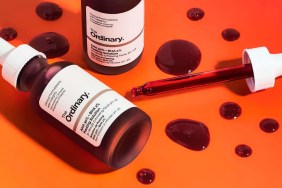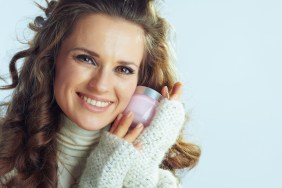Aging: we can’t stop it, but we most certainly can affect it. When it comes to skin care, how we take care of our skin now will show up on our faces in the future. Prevention is key. But let’s face it, many of us don’t use more than just sunscreen and moisturizer when we’re young. As environmental and lifestyle factors take their toll on skin, pretty soon we realize that our current beauty routine just doesn’t cut it anymore.
To give skin a boost (or erase past mistakes), the first place to start is with a serum. Actually, make it an anti-aging serum. Serums are applied after cleansing (and toning) and before your moisturizer, so even though it’s an extra step in your routine, it takes just seconds and can have a profound effect on the overall feel and appearance of your skin. So, how does a serum compare to a moisturizing cream?
The difference between your usual moisturizer and an anti-aging serum is that serums are more concentrated and generally have smaller molecules than face creams, which means that not only are the ingredients super potent, they are also absorbed more easily and penetrate into skin’s deeper layers. This makes them ideal for targeting specific problems, whether you’re battling fine lines, hyperpigmentation, redness, dry patches or uneven/dull skin tone.
If you’re in the market for an anti-aging serum, be it for prevention or targeting an existing issue, it’s important that you pick the right one for you. Here are some of the ingredients you should keep an eye out for in order to reap all the benefits from your serum and actually see the positive changes in your skin. Ingredients like glycolic acid exfoliate, retinoids accelerate cellular renewal and Vitamin C fights free radical damage. While effects of these ingredients are proven, the results are often superficial, so in addition to these, you should also look for some ingredients that work on the deeper layers of the skin.
Peptides are amino acids that carry out important biological actions. When it comes to anti-aging products, peptides are the ingredient that can help smooth out existing wrinkles, restore firmness and boost collagen production.
Stem cells are one of the most popular new anti-aging ingredients in skin care. The most common stem cells are designed to stimulate collagen production, which decreases drastically by the time we’re 30 years old. Botanical stem cells (stem cells bioengineered in plants) are what you want in your anti-aging serum.
Hyaluronic acid is found naturally in the body. It’s what keeps skin plump and dewy, but just like collagen, its levels fall as we age. When applied to the surface of the skin, hyaluronic acid attracts and retains water, which makes it the ultimate moisturizer.
Retinol is derived from Vitamin A and is one of the most popular anti-aging ingredients in cosmetic products. Here’s why: it causes skin cells to turn over more rapidly, so it improves skin texture and fine lines. Retinol also shrinks pores and prevents blackheads.
Antioxidants help prevent free radical damage. Vitamin C is a popular antioxidant found in anti-aging serums. It also gently brightens the skin.
Glycolic acid is often used in anti-aging serums and most commonly for exfoliation and cell turnover promotion.
Now that you know what to look for in the best anti-aging serum for you, click through the slideshow above to discover some of the top-rated products under $25.
[ Next: 39 Drugstore Skin Care Products Dermatologists Swear By ]
best anti-aging serum
-
best anti-aging serum #1

MIZON Collagen 100, $11.19 at Amazon
Collagen makes up 70 percent of the inner skin but as we near our 30s, collagen production rapidly decreases. As a result, skin loses elasticity and radiance. This best anti-aging serum utilizes marine collagen and hyaluronic acid to help firm, plump and hydrate skin. It also contains ingredients to help combat signs of aging.
-
best anti-aging serum #2

L'Oréal Age Perfect Hydra-Nutrition Advanced Skin Repair Daily Serum, $19.99 at Ulta
As we mature, so does our skin as it gradually loses essential nutrients. When you add years of environmental damage, such as sun exposure, this can cause skin to become dull, parched and less resilient. This serum features a complex enriched with bio-peptides and ceramides that help reverse the signs of past damage. Formulated with key anti-aging ingredients, skin is plumped from within and becomes more toned, resilient and younger-looking.
-
best anti-aging serum #3

Alpha Skin Care Intensive Renewal Serum with 14% AHA, $18.99 at Ulta
This lightweight, water-like serum is specially formulated to refine skin's appearance, improving clarity and texture. Alpha hydroxy acids (AHAs) wash away dead skin cells and promote collagen production, minimizing the appearance of fine lines, wrinkles and large pores. Filled with a potent, concentrated blend of ingredients, it works to support collagen production, deeply hydrate skin, battle free radicals, brighten the complexion and banish puffiness.
-
best anti-aging serum #4

Andalou Naturals Turmeric + C Enlighten Serum, $24.99 at Ulta
This best anti-aging serum contains a fruit stem cell complex, turmeric and vitamin C, a powerful combo that effectively lightens, tightens and brightens skin by targeting hyperpigmentation and UV damage. It works to neutralize free radicals and at the same time, activates collagen and elastin for even tone and a firmer complexion. It's formulated for normal and combination skin.
-
best anti-aging serum #5

Neutrogena Ageless Intensives Anti-Wrinkle Deep Wrinkle Serum, $21.99 at Ulta
Looking for fast, visible results on a budget? Reach for this retinol and vitamin-rich serum that significantly diminishes crow's feet, laugh lines, under-eye wrinkles and forehead creases. A multi-vitamin complex infuses skin with anti-oxidant power to neutralize damaging free radicals. Sustained Action Retinol works continually to renew the skin and to smooth out existing wrinkles and fade age spots, giving you a clearer, more even and younger-looking complexion.
-
best anti-aging serum #6

Luminositie Apple Stem Cell Serum, $24.99 at Amazon
A rare Swiss apple that grows at the foot of the Alps is hailed as an exciting anti-aging breakthrough due to impressive lab test results: all subjects using a product containing its stem cells reported decreased wrinkles. Suitable for use on face and neck, this serum helps skin cells maintain their capacity to build new tissue, thus postponing the inevitable cell decline. It also protects against signs of aging, as it contains ingredients to help firm, lift and hydrate skin, as well as boost collagen production and prevent wrinkles.
-
best anti-aging serum #7

PURA D'OR Pro Organic 20% Vitamin C Serum, $13.99 at Amazon
With over 1,000 highly positive reviews, you know that this organic serum delivers. This is a professional strength, 20 percent vitamin C serum developed with a concentrated base of retinol and pure vegan hyaluronic acid. It increases skin elasticity and firmness, neutralizes free radicals and reduces the appearance of fine lines and wrinkles. Due to its high C content, this serum is meant to be applied at night (to avoid reaction with sunlight), so you can wake up to a more luminous complexion each day.
-
best anti-aging serum #8

HoneyLab 5 in 1 Skin Rescue Face Serum, $11.89 at Amazon
Enriched with a blend of 5 bee-derived ingredients that transform the look of dry, aging skin, this hydrating and tightening serum infuses skin with anti-aging honey and hyaluronic acid. Marine and plant botanicals firm and lift skin in an instant, smoothing the look of wrinkles. It also adds volume to sagging complexions with peptides and ceramides.
-
best anti-aging serum #9

Surface Matters Multi-Peptide Youth Maintenance Serum, $19.95 at Amazon
This advanced formula uses the power of naturally derived peptides to support the skin's own rejuvenation process. The balanced blend of ingredients works together to hydrate, smooth and tighten skin to remove fine lines and wrinkles. Ingredients include rosehip oil, raw vitamin C, hyaluronic acid and two types of naturally-derived peptides that science has shown to have smooth skin and reduce wrinkles.
-
best anti-aging serum #10

Olay Regenerist Micro-Sculpting Serum, $9.99 at Ulta
Great for prevention or when you start to notice visible signs of aging, this best anti-aging serum delivers results over time. It provides hydration to reduce the appearance of fine lines and wrinkles and is non-comedogenic (won't clog your pores). Skin-plumping amino-peptides are specially designed to regenerate surface cells and deliver anti-aging ingredients 10 layers deep into skin's surface.
-
best anti-aging serum #11

COSRX Advanced Snail 96 Mucin Power Essence, $21.00 at Ulta
This highly concentrated Korean essence contains 96 percent snail mucin, a powerful ingredient known to aid in skin repair, hydration, brightness and tone. It boasts replenishing and revitalizing nutrients to help prevent and repair existing damage, giving you ultimate elasticity while improving levels of hydration. Snail mucin has the ability to repair everything from dry patches to acne breakouts while diminishing hyperpigmentation. It works for all skin types.








